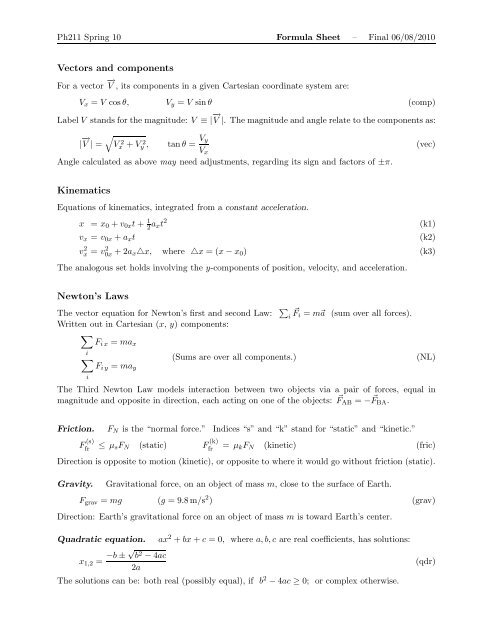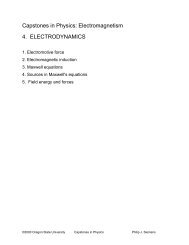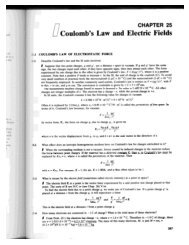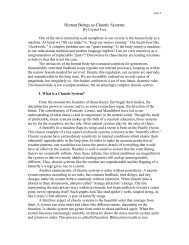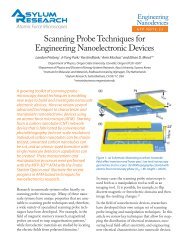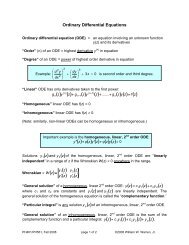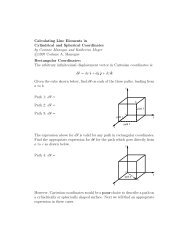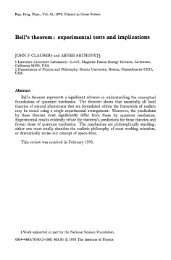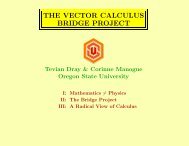Formula sheet
Formula sheet
Formula sheet
You also want an ePaper? Increase the reach of your titles
YUMPU automatically turns print PDFs into web optimized ePapers that Google loves.
Ph211 Spring 10 <strong>Formula</strong> Sheet – Final 06/08/2010Vectors and componentsFor a vector −→ V , its components in a given Cartesian coordinate system are:V x = V cos θ, V y = V sin θ (comp)Label V stands for the magnitude: V ≡ | −→ V |. The magnitude and angle relate to the components as:| −→ V | =√V 2 x + V 2 y ,tan θ = V yV xAngle calculated as above may need adjustments, regarding its sign and factors of ±π.(vec)KinematicsEquations of kinematics, integrated from a constant acceleration.x = x 0 + v 0x t + 1 2 a xt 2(k1)v x = v 0x + a x t(k2)vx 2 = v2 0x + 2a x△x, where △x = (x − x 0 ) (k3)The analogous set holds involving the y-components of position, velocity, and acceleration.Newton’s LawsThe vector equation for Newton’s first and second Law:Written out in Cartesian (x, y) components:∑F i x = ma xi∑i ⃗ F i = m⃗a (sum over all forces).∑(Sums are over all components.) (NL)F i y = ma yiThe Third Newton Law models interaction between two objects via a pair of forces, equal inmagnitude and opposite in direction, each acting on one of the objects: ⃗ FAB = − ⃗ F BA .Friction.F N is the “normal force.” Indices “s” and “k” stand for “static” and “kinetic.”F (s)fr≤ µ s F N (static) F (k)fr= µ k F N (kinetic) (fric)Direction is opposite to motion (kinetic), or opposite to where it would go without friction (static).Gravity.Gravitational force, on an object of mass m, close to the surface of Earth.F grav = mg (g = 9.8m/s 2 ) (grav)Direction: Earth’s gravitational force on an object of mass m is toward Earth’s center.Quadratic equation.x 1,2 = −b ± √ b 2 − 4ac2aax 2 + bx + c = 0, where a,b,c are real coefficients, has solutions:The solutions can be: both real (possibly equal), if b 2 − 4ac ≥ 0; or complex otherwise.(qdr)
<strong>Formula</strong> Sheet – Final 06/08/2010 Ph211 Spring 10Multiple (interacting) objectsNewton’s Laws are written separately for each, in their own coordinate systems. The interactionis represented by one of the forces from the Third Newton Law pair in each object’s equations.Work and EnergyThe work-energy relation, with W np being work done by forces without potentials:W = ∆K, or E i + W np = E f . Here E is: E = K + U (U grav , U spr , ...) (W-E)Forces may either not have potentials, like friction, or we may not know them. Note that, for forcesthat have potentials, you either use their potential energy formulas, or calculate their work.Work.W AB =The work of a force ⃗ F(⃗x), along a curve described by ⃗x, is in general calculated as∫ BA⃗F · ⃗dx =∫ BAF dx cos( ⃗ dx, ⃗ F) =∫ BAF x dx(x: parameter along the curve) (W)When a force and its angle to the trajectory are constant, its work over the path of length L is:W AB =∫ BA⃗F · ⃗dx =∫ BAF dx cos( ⃗ dx, ⃗ F) =∫ BNote that the F x above may be positive or negative.Scalar product.A∫ BF x dx = F x dx = F x LThe rule for combining (“multiplying”) vectors so to get a scalar:A(Wc)⃗A · ⃗B = ∑ i A iB i or ⃗ A · ⃗ B = | ⃗ A| | ⃗ B|cos( ⃗ B, ⃗ A) (dot)cos( ⃗ B, ⃗ A) above stands for the angle from ⃗ B to ⃗ A, taken counter-clock wise.Spring.F (x)sprThe restoring force of a spring, along the x direction:= −k ∆x(spr)∆x is the displacement of its free end from the equilibrium, in the coordinate system used.Note that it may be positive or negative, what will determine the sign of the F spr in that frame.Momentum ConservationThe total momentum of a system is conserved when ∑ Fext ⃗ = 0 (for all external forces):⃗P (tot)i= P ⃗ (tot) ∑f, or ⃗pi = ∑ ⃗p f (momenta of all particles in the system) (CoM)In perfectly elastic collisions mechanical energy is conserved too. In inelastic collisions it is not.Collected definitions and formulas. Kinetic and potential energies; and the spring force:Definition of kinetic energy K = 1 2 mv2 (Kin)Gravitational potential energy U gr = mgy (with respect to y = 0 level) (Ugr)Potential energy of the spring U spr = 1 2 k (∆x)2 (Usp)Restoring force of the spring F spr = − k ∆x (Fsp)


